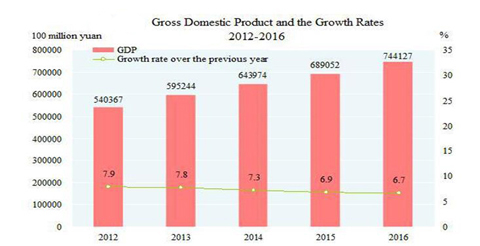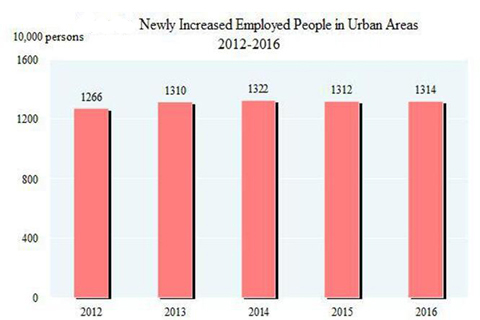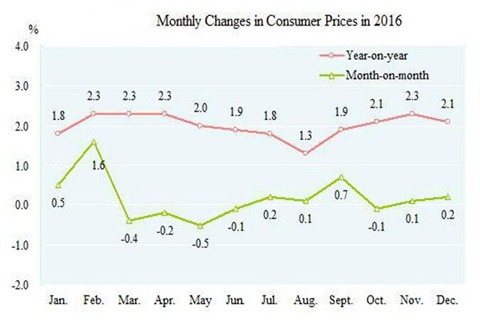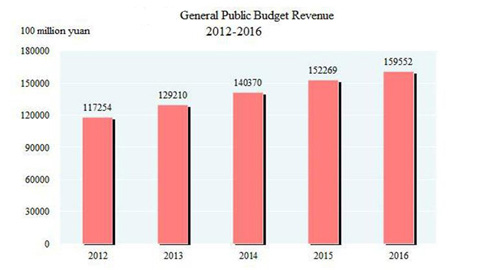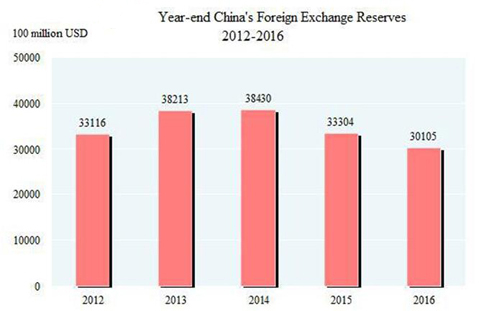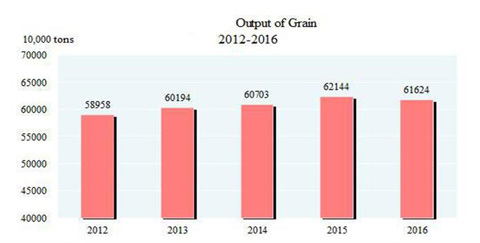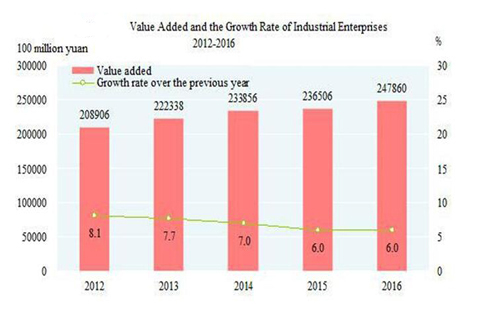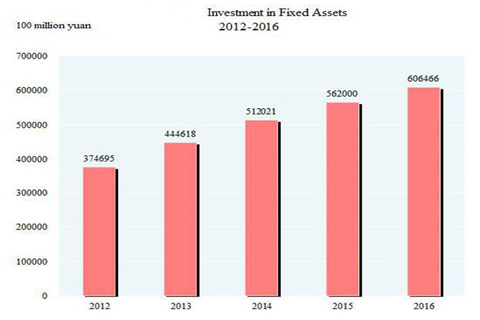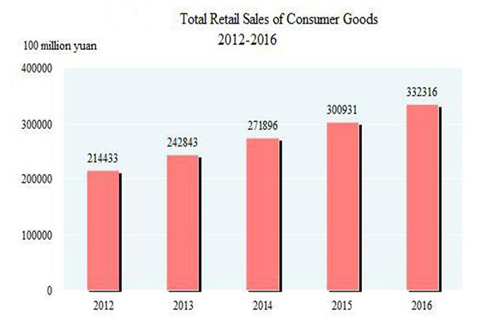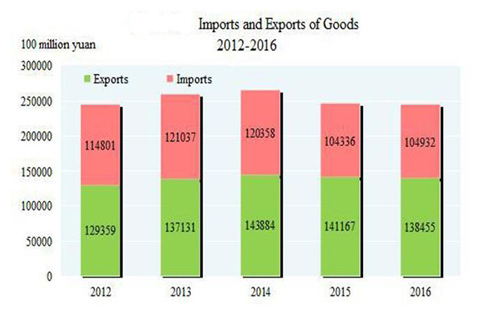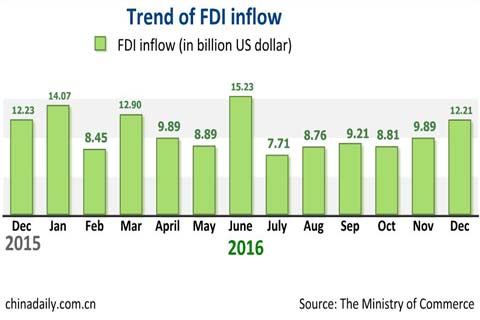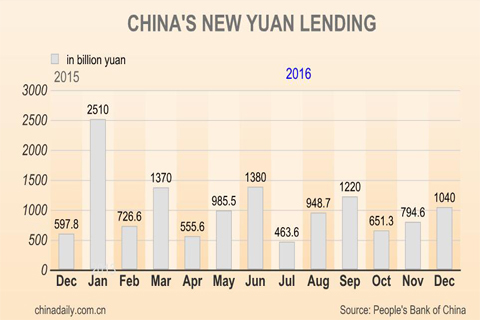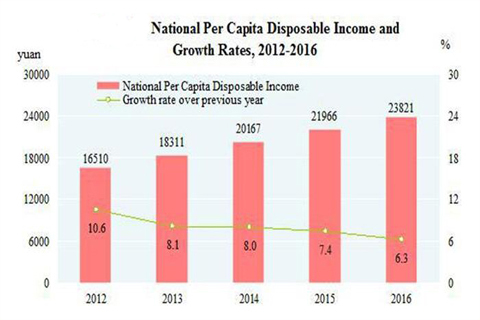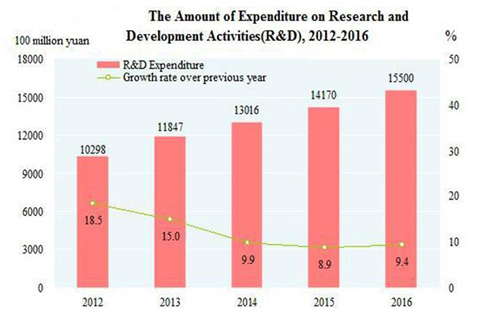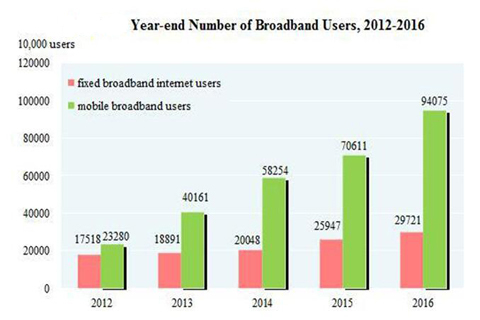China's National Bureau of Statistics (NBS) released a statistical communique on the 2016 national economic and social development on Feb 28.
The national economy has achieved steady and sound development, getting off to a good start during the 13th Five-Year Plan period (2016-2020), the communique said.
Here are some key economic figures in the communique.
1GDP
According to preliminary accounting, the gross domestic product (GDP) in 2016 was 74.41 trillion yuan, growing by 6.7 percent over the previous year.
The value added of the primary industry accounted for 8.6 percent of the GDP; that of the secondary industry accounted for 39.8 percent; and that of the tertiary industry accounted for 51.6 percent, 1.4 percentage points higher than that in the previous year.
The per capita GDP in 2016 was 53,980 yuan, up by 6.1 percent compared with the previous year.
2Employment
At the end of 2016, the number of employed people in China was 776.03 million, and that in urban areas was 414.28 million.
The newly increased employed people in urban areas numbered 13.14 million.
The registered urban unemployment rate was 4.02 percent at the year end.
The total number of migrant workers was 281.71 million, up by 1.5 percent over that of 2015.
3Prices
The consumer prices went up by 2 percent over the previous year.
The producer prices went down by 1.4 percent.
In December, out of the 70 large-and-medium-sized cities, 65 cities showed a year-on-year rise in sales prices of new commercial residential buildings, and 5 cities experienced a decline.
4Fiscal revenue
The fiscal revenue, or the general public budget revenue, reached 15.96 trillion yuan in 2016, an increase of 682.8 billion yuan, or 4.5 percent year-on-year.
Of this total, the taxes collected in the whole year reached 13.04 trillion yuan, an increase of 543.2 billion yuan or up by 4.3 percent.
5Foreign exchange
At the end of 2016, China's foreign exchange reserves reached $3.01 trillion, a decrease of $319.8 billion as compared with that at the end of 2015.
The average exchange rate of the year was 6.6423 yuan to $1, depreciated by 6.2 percent over that of 2015.
6Agriculture
In 2016, the sown area of grain was 113.03 million hectares, a drop of 310,000 hectares compared with that in 2015.
The total output of grain in 2016 was 616.24 million tons, a decrease of 5.2 million tons or down by 0.8 percent over the previous year.
7Industry
In 2016, the total value added of the industrial sector was 24.79 trillion yuan, up by 6 percent over the previous year.
The profits made by the industrial enterprises above the designated size in 2016 were 6.88 trillion yuan, an increase of 8.5 percent over the previous year.
8Fixed asset investment
The total investment in fixed assets of the country in 2016 was 60.65 trillion yuan, up by 7.9 percent over the previous year. The real growth was 8.6 percent after deducting the price factors.
The investment in real estate development was 10.26 trillion yuan, up by 6.9 percent.
9Retail sales
The total retail sales of consumer goods reached 33.23 trillion yuan, a growth of 10.4 percent over the previous year, or a real growth of 9.6 percent after deducting price factors.
The online retail sales were 5.16 trillion yuan, an increase of 26.2 percent compared with the previous year.
10Foreign trade
The total value of imports and exports of goods in 2016 reached 24.34 trillion yuan, down by 0.9 percent over the previous year.
The goods trade surplus was 3.35 trillion yuan, a drop of 330.8 billion yuan over the previous year.
The total value of imports and exports of services was 5.35 trillion yuan, up by 14.2 percent.
The deficit of exports minus imports of services was 1.71 trillion yuan.
11Foreign direct investment
The year 2016 witnessed the establishment of 27,900 enterprises (excluding banking, securities and insurance) with foreign direct investment, up by 5 percent over the previous year.
The foreign capital actually utilized was 813.2 billion yuan ($126 billion), up by 4.1 percent.
The overseas direct investment (excluding banking, securities and insurance) by Chinese investors was 1.13 trillion yuan, or $170.1 billion, up by 44.1 percent over the previous year.
12Financial market
By the end of 2016, money supply of broad sense (M2), which covers cash in circulation and all deposits, was 155 trillion yuan, reflecting an increase of 11.3 percent.
Money supply of narrow sense (M1), which covers cash in circulation plus money in current corporate deposits, was 48.7 trillion yuan, rising 21.4 percent.
Loans in renminbi and foreign currencies in all items of financial institutions reached 112.1 trillion yuan, an increase of 12.7 trillion yuan. Of this total, loans in renminbi were 106.6 trillion yuan, an increase of 12.6 trillion yuan.
In 2016, 248 A-shares were issued, raising 163.4 billion yuan worth of capital altogether.
A total of 8.22 trillion yuan corporate debenture bonds were issued, an increase of 1.5 trillion yuan over the previous year.
The premium received by the insurance companies totaled 3.1 trillion yuan in 2016, rising 27.5 percent over the previous year.
13Disposable income
In 2016, the national per capita disposable income was 23,821 yuan, an increase of 8.4 percent or a real increase of 6.3 percent after deducting price factors.
The per capita disposable income of urban households was 33,616 yuan, up by 7.8 percent, or a real growth of 5.6 percent after deducting price factors.
The per capita disposable income of rural households was 12,363 yuan, up by 8.2 percent, or 6.2 percent in real terms.
14R&D
Expenditures on research and development (R&D) activities was worth 1.55 trillion yuan, up 9.4 percent over 2015, accounting for 2.08 percent of GDP.
Till the end of year 2016, the number of patents in force was 6.29 million, of which 1.1 million were invention patents from home.
The number of invention patents per 10,000 people was eight.
15Telecommunications
By the end of 2016, there were 1.53 billion phone subscribers in China, of which 1.32 billion were mobile phone users.
The number of fixed broadband internet users reached 297.21 million, up by 37.74 million over the previous year.
The number of the mobile broadband users was 940.75 million, an increase of 234.64 million.
The number of internet users was 731 million, up by 42.99 million. Of the total, 695 million were mobile internet surfers, an increase of 75.5 million.
(Source: National Bureau of Statistics)
